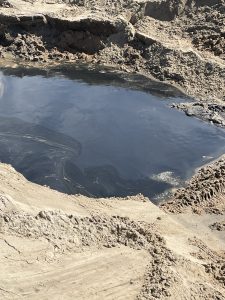
The U.S. Army Corps of Engineers (USACE) announced on Tuesday that the Savannah District was in the first stages of forming a Restoration Advisory Board (RAB) for Buxton Beach, based on an overwhelmingly positive response from the public.
In early November, the USACE launched an online survey designed to gauge the Outer Banks community’s interest in establishing a RAB for the Buxton Naval Facility, a Formerly Used Defense Site (FUDS) at the end of Old Lighthouse Road.

A section of beach in this area has been closed to the public since September 2023 when two offshore hurricanes eroded the shoreline, and revealed leftover infrastructure from a 1956-2010 military base as well as sporadic but strong petroleum smells.
The closure was expanded to include the popular Old Lighthouse Beach earlier this year, when more erosion exposed concrete, pipes, debris and elevated fuel sheens.
Because the Buxton Beach site is part of the FUDS program, the USACE is responsible for addressing the petroleum contaminants related to Navy activity from 1956-1982, while the U.S. Coast Guard is responsible for other potential contaminants from their use of the site from 1985-2010.
Debate continues on which agency will clean all of the abandoned infrastructure, and will spearhead proactive steps to stabilize the beach, outside of an upcoming 2026 Buxton Beach nourishment project already planned by Dare County.
As outlined by the USACE at a Nov. 4 meeting, RABs are designed to bring the community together—in a more formal and structured manner than a typical public meeting—to enable the exchange of restoration information between regulatory agencies, the USACE and interested community members.
Although they are not a decision-making group, members of a Restoration Advisory Board can influence the cleanup decisions through discussions of ideas, concerns, questions and providing direct feedback to the USACE and regulatory agencies. Meetings are formal, but are open to the public.

“We’re in favor of it. I think that it demands accountability, at least in the short term when it’s still really needed,” said Buxton Civic Association (BCA) board member Heather Jennette in an earlier interview.
“It makes us more than just public comments – It makes us a stakeholder,” added BCA board member Brian Harris. “It makes it so that we have a voice.”
90 surveys were received in a 30-day period, and the majority of the respondents indicated they would like a RAB to be established. Less than half of the respondents said they would participate in the RAB meetings, per the USACE.
“The preliminary survey results indicate an overwhelming desire to establish the RAB,” said Col. Ron Sturgeon, USACE’s Savannah District Commander. “My team will document this determination and take the next steps to ensure the appropriate community representatives are on the board, and they will set a date for the kick-off meeting.”
Meanwhile, since the USACE announced in September 2024 that they were launching an imminent response action to address the petroleum, the approximate removal quantities have continued to increase.
As of early December, the team has removed 3,426 cubic yards and 61,526 gallons of petroleum-impacted soil and water, and 278,000 pounds of concrete.

The pipe footage, along with wire and cable footage, has remained unchanged at 1,153 feet of pipes and 1,088 feet of cable and wire.
The team will complete the response action by mid-December, and will return in the spring to plant native vegetation along the dunes.
Additionally, the USACE’s comprehensive sampling plans continue to progress. An initial meeting was held on Dec. 6, to discuss project objectives, scope and schedule. Once the timeline has been determined, it will be released to the public.
There’s hope that this upcoming soil and groundwater sampling plan will provide more answers, as it will examine the entire 50-acre site, focusing on areas that have historically had less investigation work and where access during 2004 removal activities was limited by buildings, roads or subsurface infrastructure. However, results may not be available until sometime in 2025, according to an update at the Sept. 3 Board of Commissioners meeting.
- For more information from the USACE, visit their Buxton Naval Facility FUDS website.
- For more information from the Cape Hatteras National Seashore, visit their Buxton Beach Access website
- Developing info from the Buxton Civic Association (BCA) can also be accessed via the organization’s website at BuxtonCivic.com or through the BCA’s official Facebook page.










